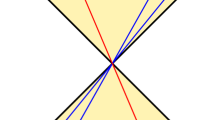Abstract
Relative distance and velocity magnitudes between two arbitrarily moving particles are independent of an observer's reference frame, and may be used to construct theoretically a clock whose rate is Lorentz-invariant. This result is in accord with the principle of relativity, using the interaction interpretation: Relativistic changes arise in association with momentum-energy transfer, rather than in consequence of velocity-induced changes in measuring clocks and rods.
Similar content being viewed by others
References
A. Einstein,Ann. Phys. 17, 891 (1905).
R. Schlegel,Found. Phys. 3, 169, 277 (1973).
R. Schlegel,Found. Phys. 5, 197 (1975).
R. Schlegel,Time and the Physical World (Dover, New York, 1968), Chap. 7.
A. Aurilia and F. Rohrlich,Am. J. Phys. 43, 261 (1975).
R. Hagedorn,Relativistic Kinematics (Benjamin, New York, 1964).
A. Einstein,The Meaning of Relativity (Princeton Univ. Press, 1945), p. 34.
R. C. Tolman,Relativity, Thermodynamics, and Cosmology (Oxford University Press, 1934), p. 25.
C. W. Misner, K. S. Thorne, and J. A. Wheeler,Gravitation (Freeman, San Francisco, 1973), p. 65.
J. S. Hafele and R. E. Keating,Science 177, 166 (1972).
R. Schlegel,Am. J. Phys. 42, 183 (1974).
Author information
Authors and Affiliations
Rights and permissions
About this article
Cite this article
Schlegel, R. A Lorentz-invariant clock. Found Phys 7, 245–253 (1977). https://doi.org/10.1007/BF00709010
Received:
Issue Date:
DOI: https://doi.org/10.1007/BF00709010




